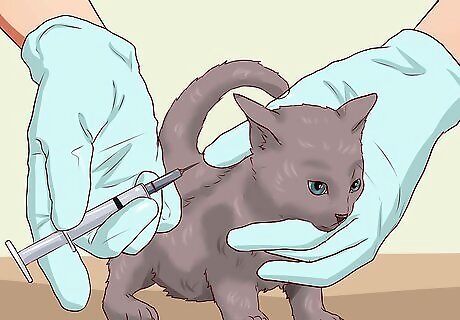
views
Getting Prepared

Observe the cat for a while. Before you catch or even approach a stray cat, you need to observe them for signs of disease and injury. For your own safety and the safety as a cat, it's important to evaluate the health of the animal and come up with a viable plan for determining when and how to help. If a cat has been frequenting a particular area for a few days, spend some time watching it closely. If it's a friendly cat, your job will be a lot easier. If not, you've got some work to do. If a cat behaves erratically, breathes heavily, drools excessively, or generally acts lethargic and unusual, call animal control. Do not attempt to approach cats exhibiting signs of disease. There are some diseases that cats carry that are zoonotic—or transferred to humans from animals and vice versa. A very frightening, and virtually untreatable disease is rabies transmitted by saliva through bites or cuts in the skin. Another danger is the dangerous infections that can set in from cat bites. Professionals who work at animal control have the necessary equipment and protection to safely capture sick stray cats. Not every cat needs to be caught. Don't try to catch well-fed looking cats with collars. Call your neighbors and inquire about whether or not anyone’s missing a stray, instead. EXPERT TIP Pippa Elliott, MRCVS Pippa Elliott, MRCVS Veterinarian Dr. Elliott, BVMS, MRCVS is a veterinarian with over 30 years of experience in veterinary surgery and companion animal practice. She graduated from the University of Glasgow in 1987 with a degree in veterinary medicine and surgery. She has worked at the same animal clinic in her hometown for over 20 years. Pippa Elliott, MRCVS Pippa Elliott, MRCVS Veterinarian Pippa Elliott, a licensed veterinarian, explains: "Feral cats that have previously been trapped and neutered often have been 'ear tipped' or have a flat tip to one ear. If you see this, the cat is already doctored and doesn't need to be caught."

Get a live trap. Live traps are extremely safe and simple mechanisms that catch cats easily and humanely. You bait the trap with food, and then the doors of the cage will close when an animal wanders inside, trapping it safely. After trapping a stray cat, leave it in the live trap and transport it to the vet. Do not remove the animal from the trap. Local vets and animal shelters will lend you live traps for catching strays. You don’t have to buy one, though it might be a good tool to have on hand if you live in a rural area and commonly encounter strays and other animals in need of relocation. If you absolutely can't find or use a trap, use a cat carrier or a box to bait with food and trap the cat inside. Check with your vet before using a carrier to catch a cat some vets won't accept cats that are brought to them in anything except a live trap. A live trap is safer and more effective, but this can do in a pinch.

Avoid unreliable methods for catching a cat. Don’t attempt to catch a stray by picking it up or by using a pillowcase or other type of bag. These methods can anger and agitate strays, as well as injure them, and risk injuring yourself. Never, under any circumstances, should you handle a stray cat with your bare hands. Treat stray cats as you would a wild animal, even if you hope to domesticate the cat in the long run. Give it time.

Prepare an area in which to keep the cat. You'll need to have a suitable place for keeping the cat, even if you just plan on taking it to the vet and then re-releasing it. Ideally, you want to catch the cat as near as possible to the spay or neuter date, so you can take the cat immediately to the vet's office. If you need to house the cat for a little while before, though, you need to prepare a quiet room in the house for the cat to stay. Strays should be kept in out-of-the-way areas of your house that you can keep quiet so the cat will calm down and feel safe. Basements, spare bedrooms, and other temperature controlled areas that you can keep dark will help to calm cats and keep them feeling safe. If you're taking the cat to the vet in less than 12 hours, don't worry about feeding the animal. It'll be fine and it'll be much safer to avoid opening the cage and risking having to wrangle the cat again. Provide some clean water and let the cat stay in the live trap.

Set up an appointment to have the cat neutered and medically checked out. The ASPCA now promotes a policy called Trap Neuter Return (TNR). Whatever you intend to do with the animal after you’ve caught it, this needs to be the first step after catching it.
Trapping a Stray

Start feeding the cat a couple of days before you want to trap it. You want to make sure the cat will start having a reason to stay around the area, and then will have a reason to take the food that you've set into the trap. After making an appointment to have the cat treated at the vet, withhold food for a day or two leading up to the appointment, before you set your trap for the cat. Use regular dry cat food from the store, or canned cat food to feed the cats. In a pinch, a small amount of tuna or other canned fish will also attract cats if you’d rather not buy cat food. Don’t feed cats milk. Contrary to popular belief, cats have difficulty processing dairy, and you can end up with a mess on your hands by feeding cats milk. Feed strays solid cat food.

Set up the trap and bait it. Use the same variety of cat food or treats that you’ve been using to feed the cat. Set down paper or a pillowcase to smooth out the wire floor of the cage, and place food at the back of the cage so the cat has to walk all the way in to eat it, put a small amount of food at the entrance of the trap as a teaser, then set the spring on the trap. Each trap will be operated slightly differently, but all are fairly basic. For the most part, you only need to open the trap door and secure it in place with the wire release bar. When the door closes, the animal will be trapped inside. Cover the trap with a towel or cloth without obscuring the entrance, to help obscure the trap and make it look less conspicuous. Some hard to catch cats prefer to be able to see through the back of the trap. If you are having trouble catching a cat try removing the cover or leaving the back exposed. Don't use a bowl to keep the food in. The cat might thrash around once caught and could hurt itself on any objects stuck inside the cage.

Check on the trap regularly. Live traps are very safe, but you don't want to leave a cat outdoors and exposed in an unattended trap for a long period of time. This means it is important to check up on it regularly and see whether or not you've made the catch. If so, bring it indoors to your prepared area, or take it to the vet immediately if it's time.

Take the cat indoors. Once the cat is trapped, cover the trap with the cloth and promptly move it to the holding area. The cat will be more calm if kept in the dark when you are moving it, so lower the light and keep a cover over the cage. Leave the cat in the trap. Don't let the cat out of the trap or try to transfer it to a cat carrier, or you're just going to have to start the whole process over again. After being caught and moved around, cats will want to hide in a small, cramped space, anyway, making the cage the ideal location for them at this time. The cat will be fine!
Finding the Stray a New Home

Have the cat neutered and medically treated if necessary. Have the cat neutered (male) or spayed (female) and at a minimum the cat should also have a rabies vaccination, treatment for any parasites (fleas or worms), vaccination for distemper, and a test for feline leukemia is also recommended. In many places, these services are offered for free as a general animal control policy.

Re-release the cat. Female cats should be kept under observation in a cage with access to a litter box and food and water for 5 days after the spay operations. Males can be released the day after the operation. You can return it back to the habitat from which it came, or take it elsewhere. If releasing the cat to a new area a caregiver needs to be available to help the cat become acclimated to its new environment, which can take several weeks. In general, this policy is promoted by the ASPCA as a way of helping to control the cat population. If the cat seemed to be getting on well in the environment, release it and put food, water and shelter out regularly. Cats that are released to areas they are not familiar with are unlikely to survive unless they have a caretaker because they do not have a source of food, water, or shelter. Other cats already in the area may also attack them in territory disputes.

Contact a local cat rescue organization or non-kill animal shelter. If you live in an urban area, releasing a stray might be irresponsible. Cat rescue and no-kill shelters are a much better option. They will likely be happy to do the work of finding the cat a good home. Feral cats are almost never adopted from shelters, as they have a high euthanasia rate of more than 90%. If the cat is unadoptable it is better to release to the area where it was caught. Many rescues will pay the cost of a stray cat's veterinary bills for you. Save your receipts. If you can, offer to foster the cat until a home is found. Some organizations have more cats than they have foster homes. Just don't take offense if they prefer to foster with someone who has experience with cats.

Try to find the cat a new home, if necessary. If you're sure the cat is not owned and you're uncomfortable or unable to take the cat elsewhere, find a suitable home for the cat yourself. You can advertise, ask around, and find a suitable candidate for keeping the cat for a pet. Ask around informally to see if any of your friends or relatives might be interested in looking after the cat. Start by asking trusted friends and acquaintances. This way the cat gets a good home, and you can visit it sometimes. Advertise the cat locally. Put the cat on Petfinder.com. Make sure the profile is honest about the cat's situation. You can also put an ad online or in the local classifieds.

Consider keeping the cat. Some stray cats make great pets once they adjust to life in a human home. Think carefully about whether you have the time, money and a good environment to take on a pet. If you plan on keeping the animal, make sure that it gets looked after thoroughly at the vet and that it's a safe animal to be around before letting it into your home.
















Comments
0 comment